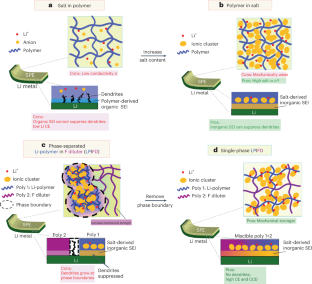Single-phase local-high-concentration solid polymer electrolytes for lithium-metal batteries
IF 60.1
1区 材料科学
Q1 ENERGY & FUELS
引用次数: 0
Abstract
Solid polymers are promising electrolytes for Li-metal batteries, but they have limitations: they cannot simultaneously achieve high ionic conductivity, good mechanical strength and compatibility with high-voltage cathodes while suppressing Li dendrites. Here, we design a class of locally high-concentration solid polymer electrolytes based on polymer blends, which are termed Li-polymer in F diluter (LPIFD). The Li-polymer (polymer-in-salt) ensures continuous Li-ion conduction channels and contributes to the solid electrolyte interphase (SEI), and the F diluter (inert fluorinated polymer) adds mechanical strength. Studies reveal that a single-phase LPIFD, which is based on a miscible polymer blend, lacks phase boundaries and forms an organic-less and LiF-rich SEI, effectively suppressing lithium dendrites. The single-phase LPIFD delivers ionic conductivity of 3.0 × 10−4 S cm−1, and enables the Li anode to reach a high coulombic efficiency of 99.1% and a critical current density of 3.7 mA cm−2. Furthermore, the ability to form an F-rich cathode electrolyte interphase allows LiNi0.8Co0.1Mn0.1O2||Li cells to achieve a cycle life of 450 cycles at a high operating voltage of 4.5 V. This design will inspire efforts to commercialize polymer electrolytes for high-energy Li-metal batteries. Batteries with solid polymer electrolytes face challenges in electrochemical stability and compatibility with high-voltage cathodes. Chunsheng Wang and colleagues have developed a polymer blend with a high Li salt concentration that enhances the stability of solid polymer electrolytes and achieves promising electrochemical performance in full-cell applications.


用于锂金属电池的单相局部高浓度固体聚合物电解质
固体聚合物是很有前途的锂金属电池电解质,但它们也有局限性:它们无法同时实现高离子电导率、良好的机械强度以及与高电压阴极的兼容性,同时抑制锂枝晶。在此,我们设计了一类基于聚合物混合物的局部高浓度固体聚合物电解质,这种电解质被称为 "锂聚合物 F 稀释剂(LPIFD)"。锂聚合物(盐中聚合物)可确保连续的锂离子传导通道,并有助于形成固体电解质间相(SEI),而F稀释剂(惰性含氟聚合物)则可增加机械强度。研究表明,基于混溶聚合物混合物的单相 LPIFD 缺乏相界,可形成无有机物且富含锂氟的 SEI,从而有效抑制锂枝晶。单相 LPIFD 的离子电导率为 3.0 × 10-4 S cm-1,可使锂阳极达到 99.1% 的高库仑效率和 3.7 mA cm-2 的临界电流密度。此外,由于能够形成富含 F 的阴极电解质间相,镍钴锰锂电池在 4.5 V 高工作电压下的循环寿命可达 450 次。这一设计将推动高能锂金属电池聚合物电解质的商业化。
本文章由计算机程序翻译,如有差异,请以英文原文为准。
求助全文
约1分钟内获得全文
求助全文
来源期刊

Nature Energy
Energy-Energy Engineering and Power Technology
CiteScore
75.10
自引率
1.10%
发文量
193
期刊介绍:
Nature Energy is a monthly, online-only journal committed to showcasing the most impactful research on energy, covering everything from its generation and distribution to the societal implications of energy technologies and policies.
With a focus on exploring all facets of the ongoing energy discourse, Nature Energy delves into topics such as energy generation, storage, distribution, management, and the societal impacts of energy technologies and policies. Emphasizing studies that push the boundaries of knowledge and contribute to the development of next-generation solutions, the journal serves as a platform for the exchange of ideas among stakeholders at the forefront of the energy sector.
Maintaining the hallmark standards of the Nature brand, Nature Energy boasts a dedicated team of professional editors, a rigorous peer-review process, meticulous copy-editing and production, rapid publication times, and editorial independence.
In addition to original research articles, Nature Energy also publishes a range of content types, including Comments, Perspectives, Reviews, News & Views, Features, and Correspondence, covering a diverse array of disciplines relevant to the field of energy.
 求助内容:
求助内容: 应助结果提醒方式:
应助结果提醒方式:


